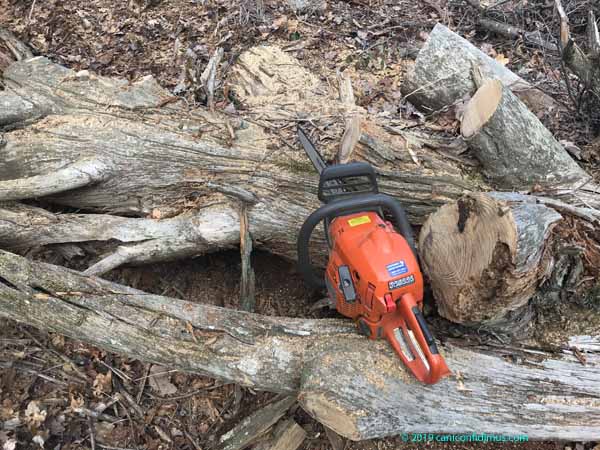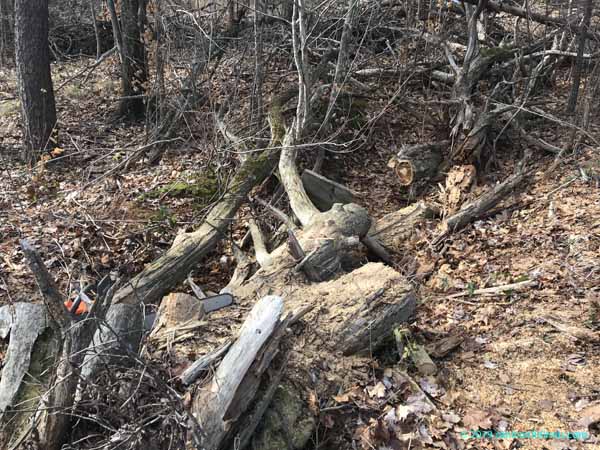Cedar trees are not common on the mountain, but they once were. They exist today mostly, but not entirely, as fallen, dead trees. I have scavenged a few downed cedars in the past for firewood. My miscalculation on how much firewood I would need this winter sent me out in the yard on Tuesday to cut up another one.
This tree is about 30 feet from our driveway in the most overgrown part of our property. A small part of the property on the north end has fairly mature hardwoods. The eastern and southern parts of the yard were apparently clear cut, or almost clear cut, and have grown back in a thicket of densely-packed, small pines with a few larger pines and maples.
I have not seen one live cedar on the property, but this dead one must have been a giant among cedars. Here is my chainsaw for scale.

It’s hard to see the size of the trunk at its base. I counted about 50 rings in the branched trunk next to the saw. The main part of the trunk is a minimum of a yard in diameter. Here it is from a different angle.

My chainsaw is just visible on the left. Note that the bar on my chainsaw is 20 inches.
This tree was a monster of a cedar, or, more properly, a juniper. This is from the Wikipedia entry on the eastern red cedar:
Juniperus virginiana is a dense slow-growing coniferous evergreen tree that may never become more than a bush on poor soil, but is ordinarily from 5–20 m or 16–66 ft tall, with a short trunk 30–100 cm or 12–39 inches in diameter (rarely to 27 m or 89 ft in height, and 170 cm or 67 inches in diameter.
This tree is certainly at the upper end of the usual trunk diameters.
Another web site calls the eastern red cedar a “moderate to long-lived evergreen,” and says that some specimens have been known to live more than 500 years.
Our specimen fell to the ground a long, long time ago. This type of cedar is resistant to rot and insects, so they can lie on the ground for years without rotting into mulch like most trees in our area. This tree has certainly been on the ground for longer than the almost 14 years we have lived on the mountain. It probably fell a good bit before I started building our first house, and that was 20 years ago. Given the rot-resistance and the condition of some of the tree, I wouldn’t be surprised to learn that it fell 30 or 40, or even 50 years ago. And, given its size, it might well have been growing on the mountain during the civil war.
There has been some rot. Some of the ends of the branches have dried out and have begun to simply disintegrate. But some of the wood is still firm, and it still produces that characteristic cedar smell when it is cut. Once the moisture from the recent rain has dried, I expect it will produce a decent, aromatic fire.
![]() Then we had some more rainy weather, with wind this time. Some places south of here had severe storms and even tornadoes, but not here. And then Sunday dawned clear and cool. The leaves looked pretty much the same as the picture I took last week, so I’ll let that suffice.
Then we had some more rainy weather, with wind this time. Some places south of here had severe storms and even tornadoes, but not here. And then Sunday dawned clear and cool. The leaves looked pretty much the same as the picture I took last week, so I’ll let that suffice.